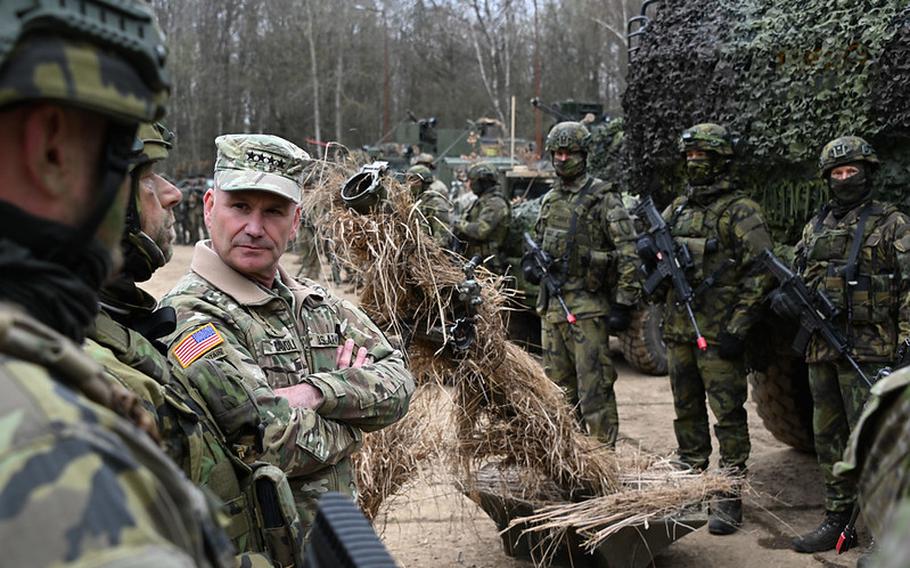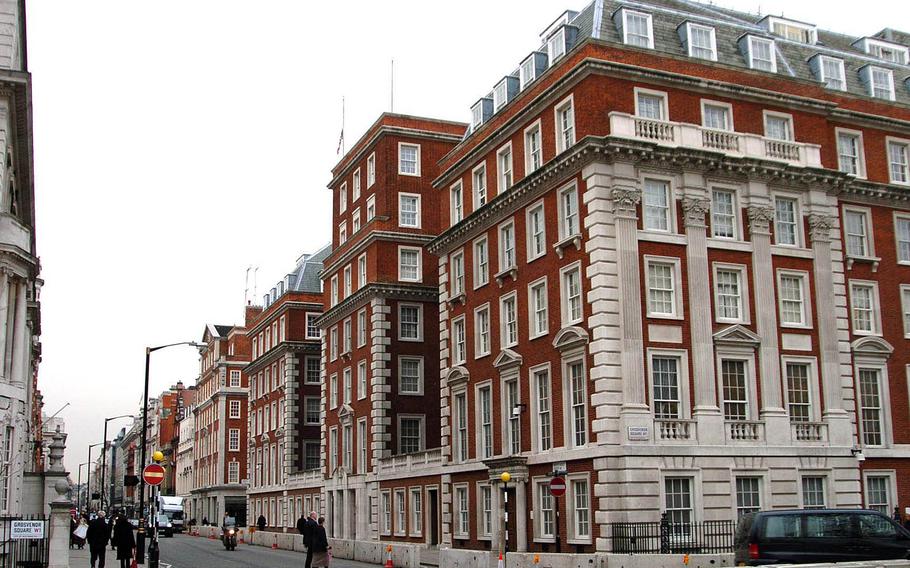
U.S. Army Gen. Christopher Cavoli, NATO’s top military commander and head of U.S. European Command, speaks with allied troops during a visit to Slovakia in March 2024. The U.S. should revive 7th Army in Europe and NATO should make changes to its command structure, a new Atlantic Council report suggested. (U.S. Embassy Bratislava)
STUTTGART, Germany — The U.S. 7th Army should be reactivated in Germany and the Navy’s European headquarters in Naples should be relocated to the United Kingdom as part of a revamped NATO structure, according to a new Atlantic Council report.
“As presently constituted, the NATO Command Structure is not fit for purpose in a post-2022 NATO,” the Washington-based think tank said in the report, which was released Wednesday.
Since Russia’s 2014 invasion of Ukraine, NATO has already gone through numerous changes to its command structure. Among the additions are a headquarters in Ulm, Germany, focused on ensuring that military forces and gear can quickly be mobilized around the Continent in a crisis.
Gen. Christopher Cavoli, NATO’s top military commander and head of U.S. European Command, also has overhauled his headquarters based out of Mons, Belgium. Those moves have involved modified NATO command-and-control arrangements for the purpose of carrying out new regional defense plans.
Even so, more measures would be advisable, the Atlantic Council report argues, saying it’s time to consider improvements “both to deter and, if necessary, to contain and defeat a dangerous adversary.”
The analysis calls for a series of changes in how the alliance does business, including moving a NATO strategic headquarters situated in Norfolk, Va., to either Washington or Paris.
Doing so would give the Virginia-based command, which is focused on military modernization but said by some experts to have “second class” status, more political clout in the NATO bureaucracy, the report said.

The U.S. Navy Europe headquarters were once in London until it moved to Naples, Italy in 2009. A new Atlantic Council report suggests the headquarters should move back to the United Kingdom. (U.S. Navy)
Another move would have Joint Force Command Brunssum shift from the Netherlands to Poland, where a four-star Polish general would take charge.
The move lines up with Poland’s emergence as a major land power in Europe and would focus efforts more sharply on the threat Russia poses to NATO’s eastern flank, wrote report author Richard Hooker, a senior fellow with the Atlantic Council’s Scowcroft Center for Strategy and Security.
“The growing capabilities of Poland, the importance of geographic proximity, and the reality of large-scale combat operations just across its border with Ukraine strongly suggest that JFC Brunssum should be replaced with a ‘JFC East,’ possibly located at Szczecin near the German-Polish border,” the report said.
In related moves, bringing back to life U.S. Army Europe and Africa’s 7th Army, created during World War II and disbanded in 2010, would help bolster a NATO Land Command in Turkey that’s not quite up to the job, the report said.
“Reporting (from former commanders) suggests that, while LANDCOM can effectively monitor and flag readiness and interoperability shortfalls, its ability to field a fully staffed and trained battlestaff as an effective land component command for (Supreme Allied Command Europe) remains a work in progress,” the report said.
A solution would be to reactivate 7th Army as an operational field army headquarters that would function like U.S. Central Command’s 3rd Army. The 7th Army would be able to command two or more NATO corps, the report said.
Likewise, America should consider sending U.S. Naval Forces Europe and Africa from Naples to the U.K. to London, which it once maintained a headquarters. The alliance would be better positioned to deal with the challenges posed by Russia in the north, where the bulk of Moscow’s naval forces are positioned, the report said.
In a revised NATO structure, Joint Force Command Naples would then be redesignated as “JFC South” under the command of an Italian four-star admiral.